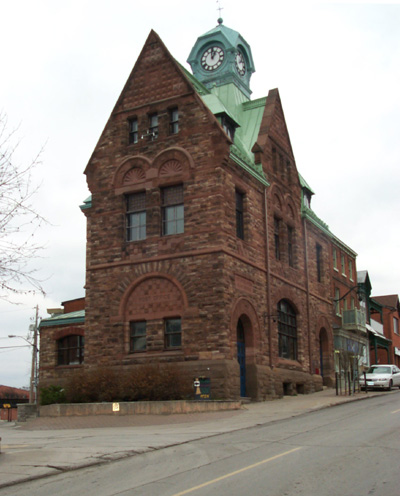Former Almonte Post Office National Historic Site of Canada
Almonte, Ontario

Street view
© Parks Canada / Parcs Canada, 2005 (Dan Pagé)
Address :
73 Mill Street, Almonte, Ontario
Recognition Statute:
Historic Sites and Monuments Act (R.S.C., 1985, c. H-4)
Designation Date:
1983-06-13
Dates:
-
1889 to 1891
(Construction)
-
1913 to 1915
(Addition)
Event, Person, Organization:
-
Thomas Fuller
(Architect)
Other Name(s):
-
Former Almonte Post Office
(Designation Name)
Research Report Number:
1979-31, Fuller Post Office
Plaque(s)
Existing plaque: On exterior façade wall 73 Mill Street, Almonte, Ontario
Begun in 1889 and finished in 1891, this building was erected to house postal and customs services. Federal chief architect Thoma Fuller was responsible for the design and Robert Camerson was the contractor. The building was part of a national programme to provide federal offices in well designed and prominently located structures. This building is influenced by the Romanesque Revival style, as the wide voussoirs over the doors and windows illustrate. The steep, picturesque roof and richly coloured and carved stone are characteristic of the period.
Description of Historic Place
The Former Almonte Post Office National Historic Site of Canada is a striking building with a steep gabled roof with central clock tower and an attractive stone exterior. It is prominently located on a triangular piece of land at the corner of Little Bridge and Mill Streets in the centre of the town of Almonte, Ontario. The late 19th-century, two-and-a-half-storey, stone building is representative of the multi-use post offices designed by Thomas Fuller. Official recognition refers to the building on its legal property at the time of designation.
Heritage Value
The Former Almonte Post Office was designated a national historic site of Canada in 1983 because: this post office by Thomas Fuller is representative of its type; having undergone no major exterior alteration, it possesses architectural merit; its siting possesses integrity;
The Former Almonte Post Office epitomizes the smallest of the multi-use post offices erected by the Department of Public Works in small urban centres during Thomas Fuller’s term as Chief Architect (1881-1886). It is representative of Fuller post offices in its two-and-a-half-storey height, its use of high-quality materials, its Romanesque Revival styling, its prominent sitting, and its interior layout. Having undergone no major exterior alteration, the post office possesses architectural merit.
Sources: Historic Sites and Monuments Board of Canada, Minutes, June 1983; Plaque Text, November 1987.
Character-Defining Elements
Key elements that contribute to the heritage character of the site include: its prominent location on a triangular piece of land at the corner of Little Bridge and Mill Streets in the centre of the town of Almonte, Ontario; its Romanesque Revival style, evident in the wide voussoirs over the doors and windows, the heavy stone gables, the polychromatic wall surfaces, the rough textured stone surfaces and the heavy, almost primitive, stone detailing; the three-bay, symmetrical main façade with two flanking entrances; the steep, picturesque gable roof clad in copper; the clock tower with its four-dial clock; its picturesque silhouette created by the interplay between the elevations, frontispiece, gables and lively roof line; the use of richly coloured, textured and carved stone, as evidenced in the basement walls of Beckwith limestone, the upper walls of locally-quarried North Elmsley sandstone and the window and door headings, sills and decorative elements of Nova Scotia red sandstone; surviving elements of the first- and third-floor plans and detailing which include the original ground floor ceiling and two small walk-in vaults that relate directly to the original function of the building; surviving interior finishes, including the moulded trim with boxed corners and bull’s eye motif around the doors and windows, the wainscoting and the staircase with heavily turned newel posts and railings; the strategic use of the wedge-shaped site on a rise of land to expose the two main façades of the building.